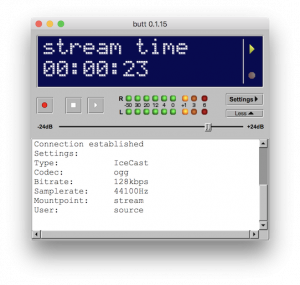broadcast using this tool

About
butt (broadcast using this tool) is an easy to use, multi OS streaming tool.
It supports SHOUTcast and Icecast and runs on Linux, Mac OS X and Windows.
The main purpose of butt is to stream live audio data from your computers Mic or Line input
to an Shoutcast or Icecast server. Recording is also possible.
It is NOT intended to be a server by itself or automatically stream a set of audio files.
Features
- Works with SHOUTcast and Icecast
- Runs on all three major operating systems. Mac OS X, Linux and Windows
- Supports aac+, mp3, ogg/vorbis, ogg/opus and flac for streaming
- Supports aac+, mp3, ogg/vorbis, ogg/opus, flac and wav for recording
- Is able to connect to a server after starting up automatically
- Is able to start a recording after connecting to a server automatically
- Recording can be split after a user defined amount of time
- Current song can either be updated manually or automatically by reading a file
- Configuration files can be imported and exported
- Status display shows infos about the current state (click on it)
- Automatically reconnects in case the connection was interrupted
- Has a VU Meter with peak hold
- Is able to attentuate and amplify the input volume
- Has a 5-band EQ
- Can read song names from different apps in MacOS and Linux
- Display colors can be changed as desired
2. Install
OS X:Mount the butt-<version>.dmg by double clicking and
drop the butt file to the Applications folder.Windows:Just run the butt-<version>-setup.exe as usual and go through the
installer pages.
The default installation path might be unusual, but this way it is possible to install
butt without administration rights.Linux/MinGW (Windows):First of all the following libraries have to be installed on your system
fltk-1.3, portaudio19, libmp3lame, libvorbis, libogg, libflac, libopus, libsamplerate, libfdk-aac, libdbus-1
They are quite common and should be included in every popular linux distribution.On Ubuntu you can install them with
sudo apt-get install libfltk1.3-dev portaudio19-dev libopus-dev libmp3lame-dev libvorbis-dev
libogg-dev libflac-dev libfdk-aac-dev libdbus-1-dev libsamplerate0-devOn Distributions which don’t have libfdk-aac like debian you can compile without aac support with:
./configure --disable-aacFor compiling on Windows I recommend the msys2 x64 (www.msys2.org) environment. They have all the needed packages in their pacman repository. Additionally you need to install the
libwinpthread-gitpackage. Make sure that you select the x64 version of each package.After installing the above libraries you can install butt from source as usual:
tar -xzf butt-<version>.tar.gzcd butt-<version>autoreconf -i(only on Windows/MSYS2)./configuremakesudo make install
In case the included configure script or the make process fails on your system, try to create a new configure script by invoking:
autoreconf -iand start with./configureagain.3. Quick start
When you start butt the first time, it will create a default configuration
file in in your home directory (~/.buttrc) on Linux and OS X or at
C:\Users\<username>\AppData\Roaming\buttrc on Windows.In order to connect to a server, you need to add a new server in the config window.
Just open the settings window and click on [ADD].
Now fill in the input fields with the server data and click on the new [ADD].Adding Stream Infos is not necessary for connecting to a server.
4. Configuration
The command line option
-c <path_to_file>allows you to define a new standard configuration path.
This makes it possible to have multiple instances with different configurations
running. In case the file does not exists, butt will create a default file.[Save]: Saves your current settings to the standard configuration
file or to the file that was passed to the -c option
[Export]: Saves your current settings to the given file
[Import]: Loads the selected file and applies the settingsCautionIf you use the -c command line option and import another configuration file by using the
import function, pressing [Save] will overwrite the file that was passed to the -c option.5. Main Window
The dot matrix display shows you the current state of the butt software.
The states are: idle, streaming, recording.
When in streaming and/or recording state you can cycle through the information by clicking on the display.
You can choose between online duration, data sent, recording duration and data recordedThe [>] symbol shines yellow if butt is connected to a server.
The [O] symbol shines orange if the[start rec. when connected]checkbox is activated.
The [O] symbol shines red if butt is currently recording.The coloured LED lights (vu-meter) indicate the current input volume. For best listening experience
for you listeners I suggest to have the input volume below or within the orange LEDs.
Never let the volume go up to the red LEDs, they indicate saturation.Gain slider: The slider is only visible when the little
[more/less]button below
the[settings]button was clicked.
With this slider you can attenuate and amplify the input signal between -24dB and +24dB, respectively.
Double clicking the slider resets the gain to 0dB. Use this slider only to fine tune your input signal.
It does not change the operating systems input volume setting. Instead, the input signal is multiplied
by the given factor. Thus adding to much gain will also add lots of noise.6. Streaming
To start streaming just klick the play symbol.
butt will try to connect to the server until you press the stop symbol.You can stream with 3 different codecs: mp3, ogg/vorbis and ogg/opus.
In case opus is selected the samplerate is always upsampled to 48kHz.
Upsampling needs lot of CPU power. You can change the upsampling
algorithm in the[Advanced]settings on the[Audio]tab. Upsampling
is deactivated if you select 48kHz as sample rate.Unfortunately, it is not possible to update Stream Infos while streaming.
You need to reconnect for updating the Stream Infos.However, at least you can update the current song on the fly.
You only need to type the song into theSong Nameinput field at the
[Stream]tab and hit Enter or click[OK].butt can also update the song automatically from a text file.
The first line of the text file must be the name of the song.
As soon as butt detects that the file has been changed it updates the
name of the song on the server.
A plugin for the amarok audio player can be found in the player_plugins/
directory.
Don’t hesitate to write a plugin for other audio players.
Just mail them to me and I’ll add them to the butt package.Stream infos:In the
[main]settings window you can add stream infos.
This allows you to deliver more details of your stream station.
For example the genre of your music, description of your station, web address etc.7. Recording
butt is able to record and stream simultaneously in different bit rates.
For example you can stream with 96kbit and record with 192kbit.
Recording is possible in mp3, ogg/vorbis, ogg/opus, FLAC or wav.In case opus is selected the samplerate is always upsampled to
48kHz.
Upsampling needs lots of CPU power. You can change the upsampling
algorithm in the [Advanced] settings on the [Audio] tab or disable it
by selecting 48kHz as sample rate. Not all sound interfaces support a
samplerate of 48kHz, though.To record you first need to select the destination folder and specify a file name
in the[Rec]tab.
butt will replace the variables%d,%mand%ywith the current day, month and year.
e.g.rec_(%m_%d_%y).mp3→rec_(03_28_2008).mp3.
Other possible time variables are%H(hours)%M(minutes)%S(seconds).With the
%ivariable you can add an index number to your file name.
This means withrec_%i.mp3butt first tries to openrec_0.mp3. If that
file already exists, butt triesrec_1.mp3and so on…If the start recording when connected checkbox is activated butt starts the
recording immediately after being connected to a server.To manually start the recording press the record symbol.
To stop recording simply click on the record symbol again.You can also tell butt to split your recording into separat files every n minutes. Just enter a number higher than 0
into the Split file every [..] minutes field.
Let’s assume your file name isrec_(%m_%d_%y)_%i.mp3Then the first file is
expanded torec_(03_28_2008)_0-1.mp3, the second after n minutes to
rec_(03_28_2008)_0-2.mp3, the third torec_(03_28_2008)_0-3.mp3, you got it.
If the sync to full hour checkbox is activated the automatic file splitting
is synchronized to the full hour. That means if the time is 8:55 and file
splitting is set to 15 minutes, the second file starts at 9:00 and the third
at 9:15.8. Uninstall
OS X:Delete the butt.app from your Application folder and
remove the configuration file from /Users/<username>/.buttrcWindows:Run the Uninstaller from the butt folder in your windows start menu.
Linux/MinGW:Run
sudo make uninstallfrom the source tree and
remove the configuration file from /home/<username>/.buttrc

